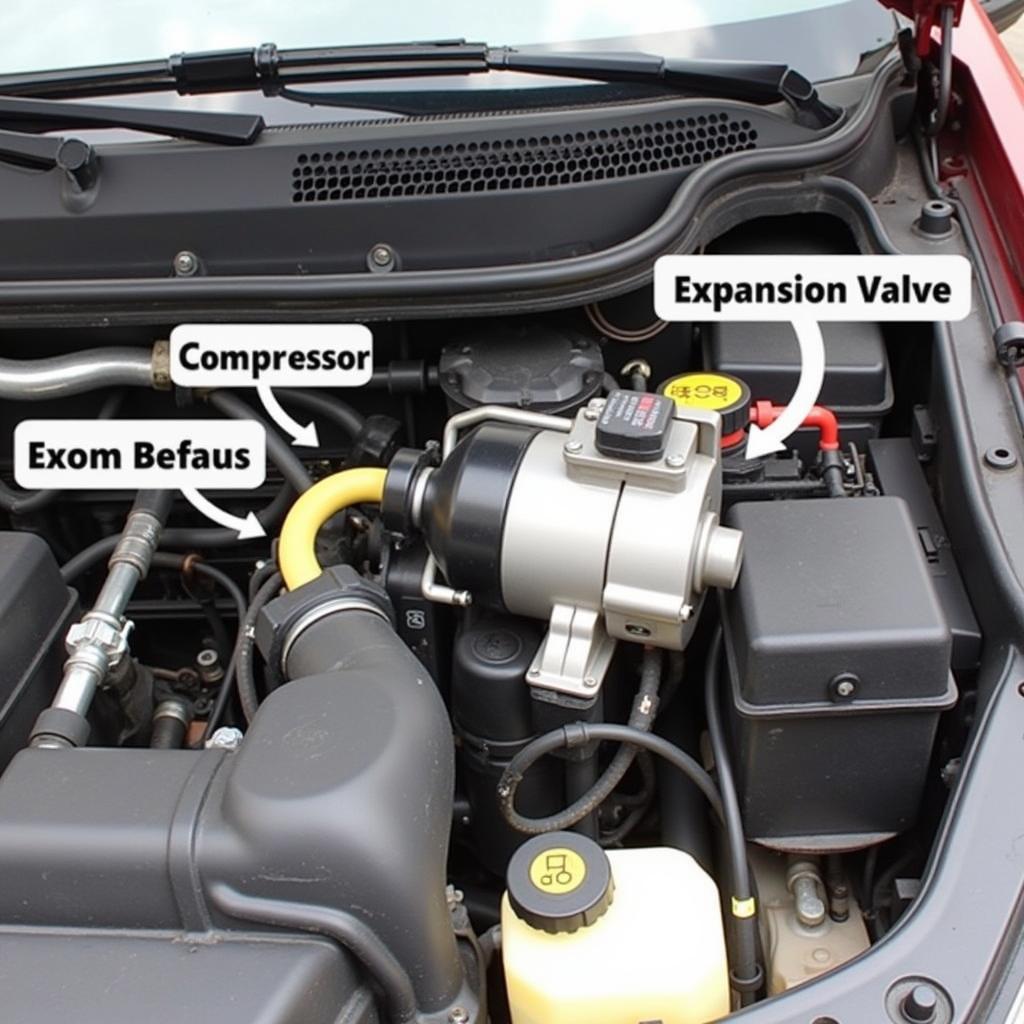Experiencing AC fix slugging in your car? This frustrating issue, where the AC intermittently blows cold and then warm air, can make driving uncomfortable, especially during hot weather. This guide will provide you with a comprehensive understanding of AC slugging, its causes, and how to troubleshoot and fix it, whether you’re a car owner, a mechanic, or an automotive technician.
Understanding AC Fix Slugging
AC fix slugging is characterized by inconsistent airflow and temperature fluctuations from your car’s air conditioning system. It often feels like the AC compressor is cycling on and off too rapidly, leading to alternating bursts of cold and warm air. This “slugging” effect can be caused by a variety of issues, ranging from simple fixes to more complex problems requiring professional attention. Understanding the root cause is crucial for effective and long-lasting repair.
Common Causes of AC Slugging
Refrigerant Issues
One of the most frequent culprits behind AC slugging is low refrigerant levels. When the refrigerant is low, the system struggles to maintain consistent cooling, resulting in the on-and-off cycling that characterizes slugging. Another refrigerant-related issue is air in the system, which can disrupt the refrigerant flow and cause similar symptoms.
Compressor Problems
The compressor is the heart of your AC system, and problems with it can lead to slugging. A failing compressor may not be able to maintain the proper pressure, leading to inconsistent cooling. A worn-out compressor clutch can also cause intermittent engagement, resulting in the slugging effect.
Expansion Valve or Orifice Tube Malfunction
The expansion valve (or orifice tube in some systems) regulates the flow of refrigerant into the evaporator. If the expansion valve is stuck or malfunctioning, it can restrict refrigerant flow, causing pressure fluctuations and ultimately, AC slugging.
 AC Compressor and Expansion Valve Components
AC Compressor and Expansion Valve Components
Electrical Issues
Electrical problems can also contribute to AC slugging. A faulty AC pressure switch, for example, can send incorrect signals to the compressor, causing it to cycle erratically. Wiring issues or a malfunctioning control module can also disrupt the system’s operation.
Troubleshooting AC Fix Slugging
Check Refrigerant Levels
Start by checking your refrigerant levels. You can use a gauge set or take your car to a professional for inspection. If the levels are low, you likely have a leak that needs to be addressed before recharging the system.
Inspect the Compressor
Listen for unusual noises coming from the compressor. Check for leaks around the compressor seals. If the compressor clutch is not engaging properly, it might need replacement.
Examine the Expansion Valve/Orifice Tube
Accessing the expansion valve or orifice tube can be challenging, and you might need professional help for this. A technician can test the component for proper function and replace it if necessary.
Check Electrical Components
Use a multimeter to check the AC pressure switch, wiring, and related electrical components. Look for any signs of damage or corrosion. Consult a wiring diagram for your specific vehicle model to ensure accurate testing.
How to Prevent AC Slugging
Regular maintenance is key to preventing AC slugging. Schedule annual AC system inspections to identify potential problems early on. Ensure the system is properly charged with refrigerant and that there are no leaks. Keep the condenser fins clean and free of debris to ensure efficient heat exchange.
“Preventive maintenance is far less expensive than major repairs. Catching these issues early can save you a lot of hassle down the road,” advises John Miller, Senior Automotive Technician at Miller’s Auto Repair.
DIY vs. Professional Repair
While some AC slugging issues can be addressed with DIY fixes, like recharging the refrigerant, others require specialized tools and knowledge. If you’re not comfortable working on your car’s AC system, it’s best to seek professional help.
Conclusion
AC fix slugging can be a nuisance, but with proper diagnosis and repair, you can restore your car’s AC to its optimal performance. By understanding the common causes and troubleshooting steps, you can either address the issue yourself or make informed decisions when seeking professional assistance. Don’t hesitate to connect with AutoTipPro at +1 (641) 206-8880 or visit our office at 500 N St Mary’s St, San Antonio, TX 78205, United States for expert advice and assistance. We’re here to help you keep cool on the road.
“Ignoring AC problems can lead to more significant damage in the long run. Addressing them promptly ensures efficient and comfortable driving,” says Sarah Johnson, Lead Mechanic at Johnson Automotive.
FAQ
- What does AC slugging feel like? You’ll experience alternating bursts of cold and warm air from your vents, as if the AC compressor is cycling on and off rapidly.
- Is AC slugging dangerous? While not inherently dangerous, it can indicate underlying problems that can worsen if left unaddressed.
- Can I drive with AC slugging? Yes, but it will be uncomfortable, especially in hot weather. It’s best to get it fixed as soon as possible.
- How much does it cost to fix AC slugging? The cost varies depending on the underlying cause and can range from a simple refrigerant recharge to more costly compressor replacement.
- How can I prevent AC slugging? Regular maintenance, including annual AC system inspections, is crucial for prevention.
- What are the signs of a refrigerant leak? Low refrigerant levels, oily residue around AC components, and a hissing sound when the AC is running can indicate a leak.
- Should I recharge my AC system myself? If you’re comfortable working with automotive systems, you can recharge it yourself. However, if you’re unsure, it’s always best to consult a professional.




Leave a Reply